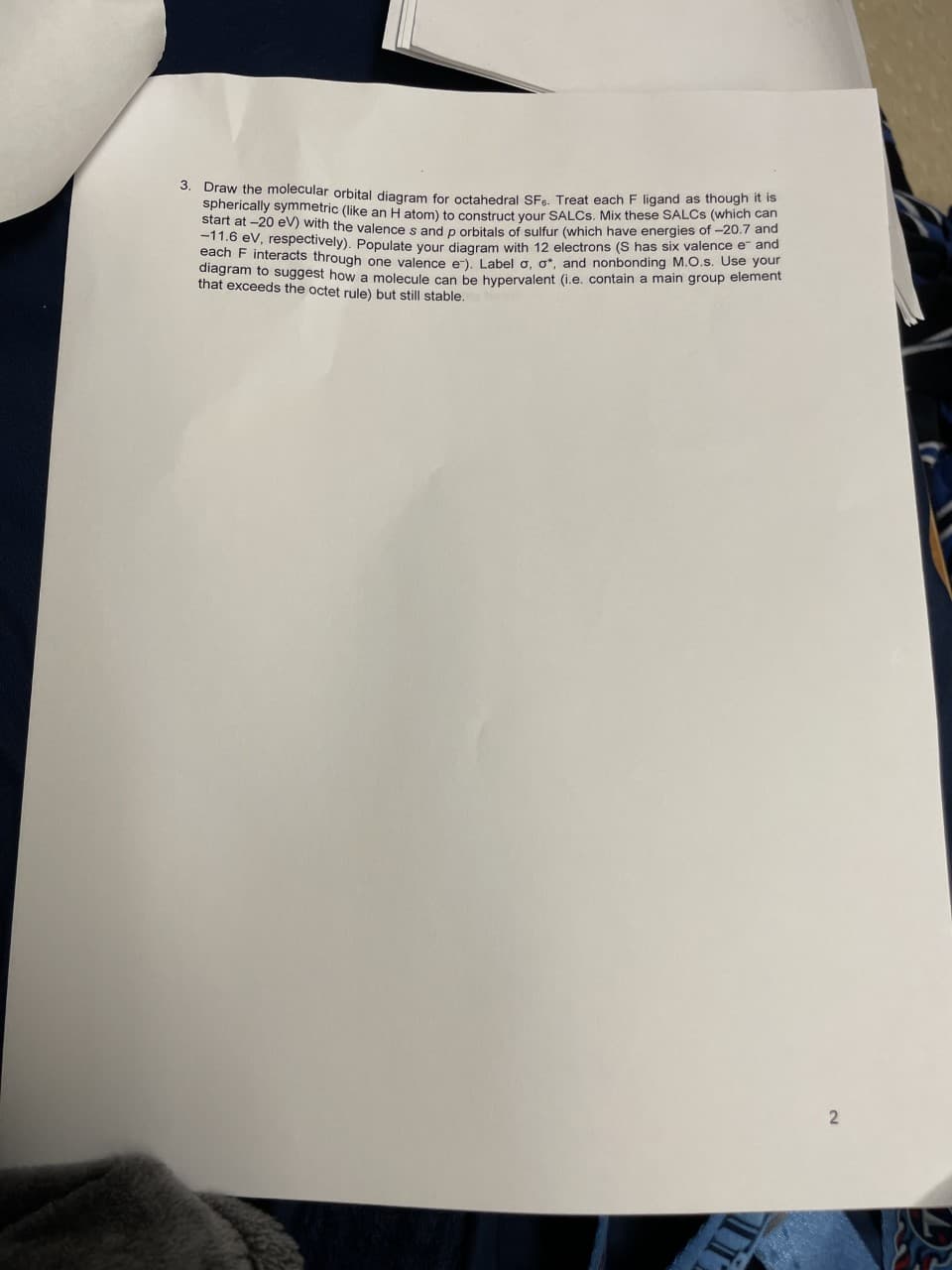Draw the molecular orbital diagram for octahedral SF. Treat each F ligand as though it is spherically symmetric (like an H atom) to construct your SALCS. Mix these SALCS (which can start at -20 eV) with the valence s and p orbitals of sulfur (which have energies of -20.7 and -11.6 eV, respectively). Populate your diagram with 12 electrons (S has six valence e and each F interacts through one valence e). Label o, o, and nonbonding M.O.s. Use your diagram to suggest how a molecule can be hypervalent (i.e. contain a main group element that exceeds the octet rule) but still stable.
Draw the molecular orbital diagram for octahedral SF. Treat each F ligand as though it is spherically symmetric (like an H atom) to construct your SALCS. Mix these SALCS (which can start at -20 eV) with the valence s and p orbitals of sulfur (which have energies of -20.7 and -11.6 eV, respectively). Populate your diagram with 12 electrons (S has six valence e and each F interacts through one valence e). Label o, o, and nonbonding M.O.s. Use your diagram to suggest how a molecule can be hypervalent (i.e. contain a main group element that exceeds the octet rule) but still stable.
Principles of Instrumental Analysis
7th Edition
ISBN:9781305577213
Author:Douglas A. Skoog, F. James Holler, Stanley R. Crouch
Publisher:Douglas A. Skoog, F. James Holler, Stanley R. Crouch
Chapter14: Applications Of Ultraviolet-visible Molecular Absorption Spectrometry
Section: Chapter Questions
Problem 14.7QAP: A 3.03-g petroleum specimen was decomposed by wet ashing and subsequently diluted to 500 mL in a...
Related questions
Question

Transcribed Image Text:3. Draw the molecular orbital diagram for octahedral SFs. Treat each F ligand as though it is
spherically symmetric (like an H atom) to construct your SALCS. Mix these SALCs (which can
start at -20 eV) with the valence s and p orbitals of sulfur (which have energies of -20.7 and
-11.6 eV, respectively). Populate your diagram with 12 electrons (S has six valence e and
each F interacts through one valence e). Label o, o, and nonbonding M.O.s. Use your
diagram to suggest how a molecule can be hypervalent (i.e. contain a main group element
that exceeds the octet rule) but still stable.
2
Expert Solution
This question has been solved!
Explore an expertly crafted, step-by-step solution for a thorough understanding of key concepts.
This is a popular solution!
Trending now
This is a popular solution!
Step by step
Solved in 4 steps with 3 images

Knowledge Booster
Learn more about
Need a deep-dive on the concept behind this application? Look no further. Learn more about this topic, chemistry and related others by exploring similar questions and additional content below.Recommended textbooks for you

Principles of Instrumental Analysis
Chemistry
ISBN:
9781305577213
Author:
Douglas A. Skoog, F. James Holler, Stanley R. Crouch
Publisher:
Cengage Learning


Principles of Modern Chemistry
Chemistry
ISBN:
9781305079113
Author:
David W. Oxtoby, H. Pat Gillis, Laurie J. Butler
Publisher:
Cengage Learning

Principles of Instrumental Analysis
Chemistry
ISBN:
9781305577213
Author:
Douglas A. Skoog, F. James Holler, Stanley R. Crouch
Publisher:
Cengage Learning


Principles of Modern Chemistry
Chemistry
ISBN:
9781305079113
Author:
David W. Oxtoby, H. Pat Gillis, Laurie J. Butler
Publisher:
Cengage Learning

Chemistry by OpenStax (2015-05-04)
Chemistry
ISBN:
9781938168390
Author:
Klaus Theopold, Richard H Langley, Paul Flowers, William R. Robinson, Mark Blaser
Publisher:
OpenStax

Chemistry
Chemistry
ISBN:
9781305957404
Author:
Steven S. Zumdahl, Susan A. Zumdahl, Donald J. DeCoste
Publisher:
Cengage Learning

Chemistry: An Atoms First Approach
Chemistry
ISBN:
9781305079243
Author:
Steven S. Zumdahl, Susan A. Zumdahl
Publisher:
Cengage Learning